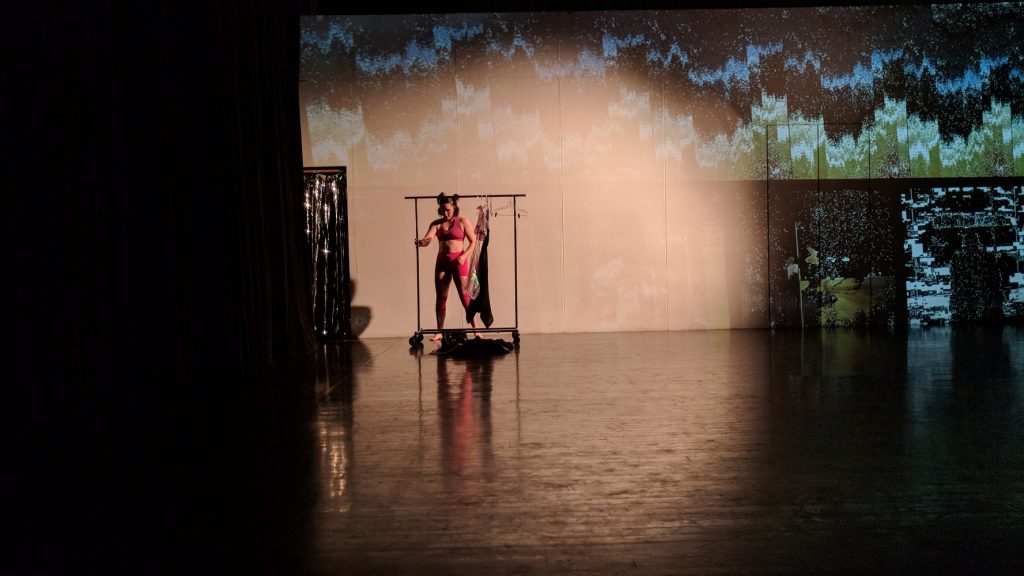Rebecca Green is a dancer, performer, choreographer and photographer who attended Cornish College in Seattle, WA and attended California Institute of the Arts. In Experiment in Three Parts that appeared at Live Arts LA, it seemed to be her experience working in photography that played a prominent influence. The capturing of emotions perhaps not observed with the naked eye, historic or mundane events seized for all posterity. Green played with and manipulated time. In doing so, she forced her audience to see and feel time passing or to wish that it would please move on. Her choreographic structure had a wonderful sense of moving still pictures that would suddenly burst into subdued emotional turbulence. Was the evening perfect? Of course not, but pulling from the title, the experiment was a success.
Part One was titled Rear View. Amy Chihara and Dina Lasso begin separately, but soon move through a series of movements that emitted a sense of memories and actions causing reactions. There were times when it felt like these women were in fact two sides of the same woman or two versions of the same memory. It was as if Green was recalling conflicted memories or reactions to a specific situation. Throughout this and Part Two, a movement theme that kept recurring was placing the head into a hand, or gently moving the head with it, projecting a sense of thought, worry, regret or moving on past that regret. Chihara and Lasso performed with great skill. Both women consistently and completely owned the extended periods of stillness, making those times feel as natural as they actually are in real life.
Interlude was stunning both visually and emotionally. Green and Emily Krause first walked slowly in darkness before being caught in a very large, pale blue spot light. The head in a hand theme continued and though these two shared the space, they appeared to not be connected. The light went off and back on, and very briefly became a strobe like flashes of a camera, catching movements of others’ lives that are gone in the blink of an eye and often unnoticed. I have often received photos credited to Green from choreographers for reviews in which there was a sense of urgency, just like in this short but fully packed Interlude.
The length of Part Two – Sparkle List is what should be taken into consideration by Green. The images are wonderful, the dancing strong and the movement was fluid, but powerful. The extended lift that demonstrates giving support over a long period of time, the accumulative phrases that move in and out of unison, the red light that totally alters the mood, the one person watching from the outside and again the thought evoking gestures are all dynamic and powerful, but in Part Two, time worked for and then against Green. The scenes became repetitive and caused this viewer to work at staying involved.
In the program, Green describes that this section was “created with 4 individual playlists from the dancers with contributions from our sound designer.” She writes that the dancers never know which order the songs will be heard, effecting how the dancers perform the very structured work. One would have to see the work more than once, of course, to fully appreciate this exercise in chance, but as a former Cunningham dancer, I can easily relate. Music effects how we move, and changing the music evokes a change of emotion. Seeing the dance only once, this aspect becomes more of an experience for the dancer than one for the audience.
I was impressed, however, at Green’s ability to bring forth different emotions and situations through what was mainly pure movement. She did so with how she grouped the performers, shifted their energy and directed our focus. Here, again, I am drawn back to how a talented photographer captures moments and/or events that help the view to see reality in a different and clearer way.
Green’s work in multi-media and the audience’s random selections of songs unite in Part Three entitled Nobody Cares You’re a Sad Girl. Beneath the chairs in the front row of the audience were white push buttons that lit up red when they were pressed. This instrument halted and changed the music when an audience member pressed it. The music was a variety of genres and moods by various artists. Projected again the back wall was a playlist that slowly dissolved into an artist’s abstract drawing of a city skyline. Also included, was a clothes rack with several different dresses and blouses hanging on it.
Emily Krause worked very hard and performed through the shifting of songs and qualities seamlessly. She had to change from a rock song into a moody blues and then be shocked into a pop music track. Sometimes the audience let her stay in one song long enough to set the tone, but other times she was only allowed a few seconds. In this case, it was the audience who did not care if she was sad or happy or if she wanted to settle into a particular emotion. If sad, someone pushed the button and made her react otherwise.
Rebecca Green’s first venture into a full evening of her own work was a strong indication that she has much more to say artistically. I look forward to seeing how she evolves. The intriguing projection and the well-crafted sound design was by Kyle McCarthy. The often rich and sometimes dramatic lighting was by Jesse Baldridge in collaboration with Bryanna Brock, Gigi Todisco and Jordan Saenz. The costumes by Rose Strasen were interesting and colorful, but did nothing to enhance the dancers’ bodies or the movement.
For more information about Rebecca Green and her work, click here.
Feature Photo: Emily Krause in Experiment in Three Parts – Photo: LA Dance Chronicle.










